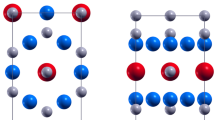Abstract
We report here our discovery of crystallographic and interstitial sites and onsite electron correlation propelled intrinsic and derived permanent magnetic properties of critical elements lean RE(TM)5 (RE = La, Ce and TM = Fe, Co) magnet materials. A full potential linearized augmented plane wave (FP-LAPW) method within the local density approximation (LDA) is used to investigate and analyze the electronic structure and magnetism of these RE(TM)5 type structures. To better correlate the experimental results, the effective Coulomb (U) and exchange (J) interactions (Hubbard parameters) are crucial at the transition metal sites. Results show that the main propeller of magnetic anisotropy in these compounds is the cobalt atoms at the 2c sites not the 3g sites. This site-specific property and site preference energetics are used to replace 3g sites with non-critical elements such as iron that exhibits a larger magnetic moment. Based on this strategic replacement, we predict two new compounds that have a larger hardness parameter with a relatively large energy product due to the atomic dilution caused by interstitial addition of nitrogen in the compounds: CeCo2Fe3N2 and LaCo2Fe3N2.




Similar content being viewed by others
References
J.P. Perdew, Phys. Rev. B 46, 6671. (1992).
H. Ucar, R. Choudhary, and D. Paudyal, J. Magn. Magn. Mater. 496, 165902. (2020).
F. Nilsson and F. Aryasetiawan, Mater. Res. Express 4, 034001. (2017).
P. Larson, I.I. Mazin, and D.A. Papaconstantopoulos, Phys. Rev. B 67, 214405. (2003).
P. Larson, I. Mazin, and D. Papaconstantopoulos, Phys. Rev. B 69, 134408. (2004).
G.I. Miletić and Ž Blažina, J. Solid State Chem. 180(2), 604. (2007).
M.C. Nguyen, Y. Yao, C.-Z. Wang, K.-M. Ho, and W.P. Antropov, J. Phys. Condens. Matter 30, 195801. (2018).
R. Choudhary, A. Palasyuk, I.C. Nlebedim, R. Ott, and D. Paudyal, J. Alloys Compd 839, 155549. (2020).
A. Asali, J. Fidler, and D. Suess, J. Magn. Magn. Mater. 485, 61. (2019).
H. Ucar, R. Choudhary, and D. Paudyal, J. Alloys Compd 836, 155263. (2020).
T. Pandey, M.-H. Du, and D.S. Parker, Phys. Rev. Appl. 9, 034002. (2018).
H. Fujii, H. Sun, and K. H. J. Buschow, Ed., Handbook of magnetic materials, in Interstitially-Modified Intermetallics or Rare-Earth and 3d Metals. Amsterdam: North Holland, 1995, vol. 9, pp. 303–404.
Y. Yang, X. Zhang, L. Kong, Q. Pan, and S. Ge, Solid State Commun. 78, 317. (1991).
Y. Yang, X. Zhang, S. Ge, Q. Pan, L. Kong, H. Li, J. Yang, B. Zhang, Y. Ding, and C. Ye, J. Appl. Phys. 70, 6001. (1991).
T. Miyake, K. Terakura, Y. Harashima, H. Kino, and S. Ishibashi, J. Phys. Soc. Jpn. 83, 043702. (2014).
Y. Harashima, K. Terakura, H. Kino, S. Ishibashi, and T. Miyake, JPS Conf Proc. 5, 011021. (2015).
M.D. Coey, Magnetism and Magnetic Materials (University Press, Cambridge, 2010).
L.H. Bolz, M.E. Boyd, F.A. Mauer, and H.S. Peiser, Acta Cryst. 12, 247. (1959).
J. Donohue, Acta Cryst. 14, 1000. (1961).
S.F. Matar, A. Houari, and M.A. Belkhir, Phys. Rev. B 75, 245109. (2007).
R. Lizárraga, F. Pan, L. Bergqvist, E. Holmström, Z. Gercsi, and L. Vitos, Sci. Rep. 7, 3778. (2017).
M. Ochi, R. Arita, M. Matsumoto, H. Kino, and T. Miyake, Phys. Rev. B 91, 165137. (2015).
Acknowledgements
This research is supported by the Critical Materials Institute, an Energy Innovation Hub funded by the US Department of Energy, Office of Energy Efficiency and Renewable Energy, Advanced Manufacturing Office. This work was supported in part by the US Department of Energy Office of Science Visiting Faculty Program (VFP) under its contract with Iowa State University, contract no. DE-AC02-07CH11358. Huseyin Ucar is grateful to the DOE for the assistantship and opportunity to participate in the VFP program. The authors would like to acknowledge Ed Moxley for providing technical support and maintaining/updating computational facilities and software packages including the Raman cluster and the WIEN2k program at Ames Laboratory. The US government retains and the publisher, by accepting the article for publication, acknowledges that the US government retains a nonexclusive, paid-up, irrevocable, worldwide license to publish or reproduce the published form of this manuscript or allow others to do so, for the US government purposes. US Department of Energy (DOE) will provide public access to these results of federally sponsored research in accordance with the DOE Public Access Plan (http://energy.gov/downloads/doe-public-access-plan).
Author information
Authors and Affiliations
Corresponding author
Ethics declarations
Conflict of interest
The authors have no conflicts of interest to declare that are relevant to the content of this article.
Additional information
Publisher's Note
Springer Nature remains neutral with regard to jurisdictional claims in published maps and institutional affiliations.
Rights and permissions
About this article
Cite this article
Ucar, H., Paudyal, D. Unraveling Site Selective Magnetic Properties of Cobalt Sites in Critical Elements Lean RE(TM)5 Magnet Materials. JOM 73, 3894–3900 (2021). https://doi.org/10.1007/s11837-021-04936-z
Received:
Accepted:
Published:
Issue Date:
DOI: https://doi.org/10.1007/s11837-021-04936-z




